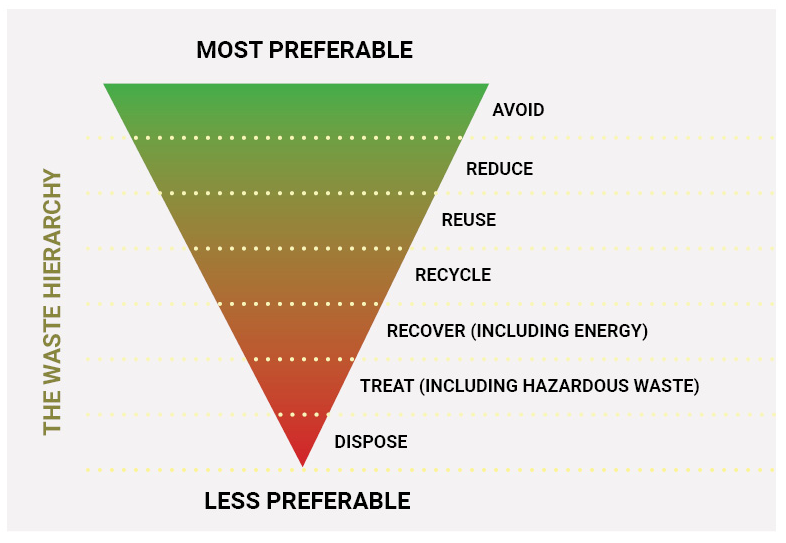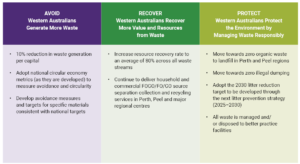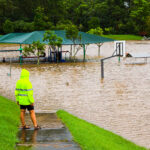In May 2024, the Western Australia Waste Authority issued its Waste Avoidance and Resource Recovery Strategy 2030 Consultation Draft (Consultation Draft Strategy).
At Talis, we understand the importance of the State Waste Strategy to provide a clear vision and targets to assist all stakeholders across the waste industry to guide future decision-making processes. We commend the Waste Authority and the Department of Water and Environmental Regulation (Department) for leading the review and inviting industry feedback.
Talis is a national consultancy with over 40 waste consultation across Western Australia (WA), New South Wales, Queensland, and Victoria. Talis’ WA waste team has over 20 full time members working on projects across the State, from remote aboriginal communities, major regional centres, through to the large metropolitan councils and state government agencies.
Our extensive experience positions us to provide valuable feedback on the Consultation Draft Strategy, especially in areas we believe could be enhanced to achieve the best outcomes for resource recovery in the State. Talis provided a response to the Waste Authority and the Department as part of the formal consultation process. Below highlights some key areas which we consider essential to improve the Draft State Waste Strategy.
Talis looks forward to seeing the progression of the State Waste Strategy review and continuing consultation with the Waste Authority and the Department throughout the process. Furthermore, our team is also keen to chat rubbish so please feel reach out if you have any questions or comments.
Definition of Recycling
Talis has identified a key issue with the definition of recycling in the Consultation Draft Strategy. The draft redefines recycling as “the use of recovered waste materials as substitutes for extracted raw materials,” which implies converting waste materials into items with market value. Across the waste industry, recycling is regarded as ‘like for like’ outcomes. We believe recycling should be defined as retaining the original physical and chemical properties of a material to produce similar products. A simple example of this is the recycling of aluminium cans back into aluminium cans.
We suggest the correct term for broader waste processing activities, including converting waste into different products or extracting energy, is resource recovery. The term ‘resource recovery’ encompasses a broader range of activities, including:
- Converting materials into different products or functions (such as Food and Garden Organics [FOGO] into compost); and/or
- Extracting various forms of value, such as energy, or heat.
Talis recommends the updated State Waste Strategy should include clear definitions which are consistent with existing industry terminology for both recycling and resource recovery. Talis recommends the following definitions for consideration:
- Recycling – the process of taking waste materials and converting them into new products or materials that retain the original physical and chemical properties, ensuring they can be used for the same or similar purposes; and
- Resource recovery – the process of extracting value from waste materials through a variety of activities including converting materials into different products or functions (such as Food and Garden Organics [FOGO] into compost) and/or harnessing energy or heat).
Priority is Landfill Diversion
Recognising the significant volumes of waste still landfilled within WA, and particularly Perth, Peel and the South West, Talis believes the State Waste Strategy should support all types of landfill diversion. This in turn should provide the flexibility to the waste industry in its decision-making process to determine the most appropriate form of resource recovery to be applied to the various waste they are seeking to divert from landfill, be it reuse, recycling or recovery
Talis recommends that the State Waste Strategy support all forms of landfill diversion equally, without favouring recycling, material recovery, or energy recovery—especially when setting targets. This aligns with the National Waste Policy (2018) goal of recovering 80% of all waste by 2030, as well as the initiatives of progressive states on the east coast, such as NSW and VIC, which have set targets of 80% waste recovery across all streams and an 80% diversion rate from landfills, respectively.
The Waste Hierarchy
The waste hierarchy is an internationally recognised and adopted framework to help guide decision making on the best outcome for waste materials. At its core, it prioritises more sustainable waste management outcomes, located at the top of the hierarchy through to the least preferred option of disposal at the bottom.
The Consultation Draft Strategy’s hierarchy only references recycling and energy recovery, while omitting the recovery of materials. Material recovery is a critical component of the circular economy, as it ensures resources remain in circulation. Recovery encompasses a broader range of activities which can result in a variety of outcomes including materials recovery (converting waste into different products) as well as the extraction of energy, heat, and other values from waste.
For consistency with Federal policy, Talis recommends adopting the National Waste Policy Waste Hierarchy diagram. This adjustment will provide a more consistent approach as well as a more accurate and comprehensive representation of recovery processes, ensuring that all forms of resource management are properly acknowledged and supported.
 National Policy Resource Hierarchy Diagram, adapted with the term ‘waste’ omitted
National Policy Resource Hierarchy Diagram, adapted with the term ‘waste’ omitted
The Circular Economy
The Consultation Draft Strategy circular economy diagram could be improved to better reflect the principles of a true circular economy and align more closely with national and international approaches. The current diagram adopts the incorrect use of the term recycling, as it is inconsistent with industry accepted definitions which regard it as ‘like for like’ outcomes.
Replacing the term ‘recycling’ with ‘resource recovery’ would more accurately reflect the broader role of material and value extraction from waste, refer Talis’ Proposed Circular Economy Model below. Talis believes this approach better reflects the comprehensive role of resource recovery in the circular economy and broader activities of material and value extraction from waste (energy, heat, etc).
Another concern with the Consultation Draft Strategy circular economy diagram is the placement of energy recovery outside the circular flow, alongside disposal (landfilling), litter, and illegal dumping. This placement undervalues the important contribution that energy recovery fulfils in achieving sustainable, circular outcomes for various waste materials. For example, waste to energy (WtE) provides material and energy recovery, which are both crucial in achieving resource recovery and landfill diversion outcomes.
 Talis’ Proposed Circular Economy Model
Talis’ Proposed Circular Economy Model
Preferencing Landfilling of Residual Waste
In the Consultation Draft Strategy, residual waste is defined as:
‘Waste that remains after the application of a better practice source separation process and recycling system, consistent with the waste hierarchy. Where better practice guidance is not available, an entity’s recycling performance will need to meet or exceed the relevant stream target (depending on its source – municipal solid waste, commercial and industrial or construction and demolition) for the remaining non-recovered materials to be considered residual waste under this waste strategy.’
In the current State Waste Strategy and the Consultation Draft Strategy, the first recover targets specify ‘energy recovery only from residual waste’. Based on the definition in both documents, any waste material can go to landfill, but only selective waste can be sent to WtE. This fundamentally preferences landfilling of waste over resource recovery, directly conflicting with the foundation principles of both the waste hierarchy as well as the circular economy.
Residual waste will continue to be generated, requiring ongoing management by the waste industry. Even countries with the most advance recycling systems, produce residual waste that must be managed effectively. These countries prioritise WtE as opposed to landfill making the material and energy recovery.
A major concern Talis has with the definition is ‘where better practice guidance is not available, an entity’s recycling performance will need to meet or exceed the relevant stream target’.
This definition appears adequate for:
The municipal solid waste (MSW) sector, where better practice guidelines do exist and can be utilised.
This definition may be inadequate for:
The commercial and industrial (C&I) sector, where there is still no best practice guidance for this stream.
Talis has previously raised concerns on the impracticality of how the best practice guidelines could be adopted in the C&I stream, recognising the significantly varied sources and types of waste generated as well as the various collection and treatment processes which may be utilised. Unlike the MSW sector, one solution does not fit all and it is still not a surprise that to date, the C&I better practice guideline has not been developed by the Department.
Therefore, in accordance with the Consultation Draft Strategy, all waste from the C&I sector will need to be landfilled unless it can achieve recycling targets. However, there is no guidance on how this would be implemented across the State including how an entity would need to measure and/or report on this to ensure that is residual waste can be diverted to WtE as opposed to landfill.
Based on modelling undertaken by Talis for various clients, across both the MSW and C&I sectors, the recycling/materials recovery targets cannot be achieved, without accounting for the proportion of material recovery from anaerobic digestion or WtE. However, as defined in the Consultation Draft Strategy, residual waste arising from the adoption of better practice recycling systems and/or achievement of resource recovery targets, can only be processed by WtE facilities. If this equation is put into an excel spreadsheet, it would raise a circular reference error which is defined as where a formula refers to a cell that’s dependent on the formula’s result.
To ensure that the State Waste Strategy is consistent with the waste hierarchy and circular economy vision, Talis strongly recommends that the definition of “residual waste” and the “recover energy only from residual waste” is withdrawn.
Leveraging the Technical, Environmental, and Economic Practicability (TEEP) Approach
The TEEP assessment evaluates waste materials based on three key elements: Technical, Environmental, and Economic Practicability to assist with determining potential outcomes. Talis has developed TEEP guidelines for Recycling Victoria through the Victorian waste to energy framework – Supporting sustainable and appropriate investment (2021), specifically for residual C&I waste permitted for WtE processing.
The table below provides examples of how this framework could be applied to residual waste intended for landfill.
 TEEP Concept and an Example Application
TEEP Concept and an Example Application
If the waste meets all the TEEP criteria, a more suitable technical solution should be used, and it should not go to landfill. However, if it fails to meet any TEEP criteria, landfill disposal is the most appropriate option. Talis recommends that WA adopt the TEEP assessment approach, as used in the eastern states, but take it further by applying it to the lowest level of the waste hierarchy: disposal/landfilling.
Proposed Targets
Based on our experience across the industry and particularly in providing guidance to local and regional council clients throughout WA, Talis emphasises the importance of adopting SMART targets:
- Specific – be clear about the action and desired outcome;
- Measurable – can be measured/tracked e.g. tonnes of waste;
- Attainable – use baseline data to estimate what may be achieved;
- Realistic – ensure it is practical; and
- Timely – state when the targets will be achieved.
Talis observes that many within the industry consider several targets in the current State Waste Strategy – many of which are now reflected in the Consultation Draft Strategy – as not meeting SMART criteria, particularly in terms of being Attainable and Realistic. This has been a key factor in the lack of widespread adoption and support for the current State Waste Strategy and its targets within the waste sector.
Talis has provided feedback in relation to each individual goal and has provided an alternative to the proposed targets for consideration which Talis believes are more realistic, attainable and align with policy at a national level.

Talis’ Proposed Targets
Talis looks forward to the continued progress of the State Waste Strategy review and ongoing collaboration with the Waste Authority and the Department throughout the process. If you would like to discuss any of these points further or have any other inquiries, please feel free to reach out using any of the contact options below.





